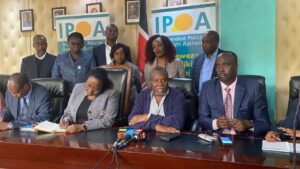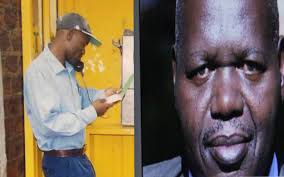Journalists Sue Police Chief and Commandants Amid AU’s Call for Media Protection
UNESCO Reports 14 Journalists Killed in Africa Between January 2023 and June 2024, Mostly in Conflict-Affected Countries

Nairobi, Sept 22 – In a bold stand for press freedom, a coalition of journalists and professional organizations have sued the Inspector General of Police, including former police chief Japheth Koome and two commandants, in response to increasing assaults and harassment of media personnel during protests. Led by the Kenya Union of Journalists, the Kenya Editors’ Guild, and the Independent Medico-Legal Unit (IMLU), the group has filed a legal petition seeking accountability for recent attacks on journalists.
The petition highlights disturbing incidents from the Finance Bill protests that erupted nationwide starting June 18. Journalists such as Catherine Wanjeri Kariuki from Kameme FM, Dominic Wanjala Wafula of the Standard Group, and freelance journalist Justus Macharia faced violence while carrying out their duties. It also details Eric Isinta’s assault during the Azimio la Umoja protests in March 2023.
“This culture of harassment threatens not only journalists’ safety but also the fundamental right to freedom of expression, a cornerstone of democracy,” the lawsuit states. It underscores the failure of police and government bodies to investigate or prosecute those responsible for these violent acts.
The lawsuit names several high-ranking officials, including the Inspector General of the National Police Service, Nakuru County Commander Peter Mwanzo, and Nairobi County Commander Adamson Bungei. Other respondents include the Independent Policing Oversight Authority (IPOA), the Attorney General, the National Police Service Commission, and the Director of Public Prosecutions. The police officials are being sued in their personal capacity under the doctrine of command responsibility, which holds them accountable for their subordinates’ actions.

As concerns grow over the treatment of journalists in Kenya, the African Union’s (AU) Peace and Security Council (PSC) has called for urgent measures to protect journalists and ensure access to information in conflict situations across Africa. At its 1230th meeting on September 2, 2024, the PSC emphasized the need for a comprehensive approach to safeguard journalists and media workers, who have increasingly become targets in war-torn and politically unstable regions.
This call comes as Africa grapples with intensifying conflicts, where attacks on journalists have risen significantly. Between January 2023 and June 2024, UNESCO reported that at least 14 journalists have been killed in Africa, with most from conflict-affected countries.
In recent months, Kenyan journalists have faced escalating threats, violence, and censorship, particularly in light of sensitive political reporting, protests, and corruption investigations. The Media Council of Kenya reported that 24 journalists were attacked and injured by police during demonstrations led by Gen Z.
Paul Ilado, head of content at Radio Africa Group, while addressing the media in Naivasha in August, urged the justice system to expedite investigations to facilitate the prosecution of those responsible for violence against journalists. He highlighted that the recent anti-government protests revealed blatant violations of press freedom, with media personnel being physically assaulted by police officers in plain view of cameras.
“We want to see clear actions and evidence of commitment by relevant government agencies to act on identified cases in order to serve justice to our colleagues who were attacked in line of duty,” Ilado said.
This alarming trend has constrained press freedom, highlighting the urgency of reinforcing protections for media practitioners in volatile environments. Reports of intimidation, arbitrary arrests, and even killings have heightened concerns both locally and internationally.
The PSC recognized that journalists in conflict zones are particularly vulnerable. It reaffirmed the essential role of journalists in informing the public, promoting transparency, and holding power accountable—functions increasingly endangered by escalating violence. In response, the PSC has put forth a series of recommendations aimed at protecting media personnel.

The AU has endorsed submissions made by UNESCO, advocating for the establishment of a National Coordination Mechanism for the Safety of Journalists and a Group of Friends for the Safety of Journalists. These initiatives aim to provide structured responses to violence against journalists, ensuring justice and fostering collaboration among governments, civil society, and international organizations.
The AU’s call for a specialized Working Group on the Safety of Journalists highlights the need for coordinated efforts to protect media practitioners across the continent. This group would facilitate sharing best practices, tracking cases of violence, and providing political support to threatened journalists.
UNESCO’s proposals emphasize the necessity of national mechanisms to swiftly address threats against journalists. The organization advocates for media literacy programs to educate the public on journalism’s vital role in democratic societies, especially amid conflict. It also stresses the need for regional legal frameworks to protect journalists’ rights and calls for enhanced cooperation between the AU and international bodies to ensure accountability for press freedom violators.
Despite being regarded as a model of democracy in East Africa, Kenya has witnessed a troubling rise in violence against journalists. Over the past decade, high-profile cases of harassment and murder have shaken the media community, with unresolved incidents like the killings of John Kituyi in 2015 and Francis Nyaruri in 2009 serving as stark reminders of the risks journalists face. Investigations by the police and the ODPP have largely failed to hold perpetrators accountable.
Recent assaults on journalists during demonstrations underline this ongoing crisis. For example, Nehemiah Okwemba and Reuben Ogachi were severely beaten by General Service Unit officers on April 19, 2015, with little to no repercussions for the assailants.
This climate of violence is not isolated; the tragic case of Pakistani TV anchor Arshad Sharif, who was shot dead by police at a roadblock nearly two years ago, drew international outrage. On July 8, the Kajiado High Court awarded Sharif’s widow 10 million shillings (approximately $78,000) in compensation, underscoring the severe consequences faced by journalists who challenge powerful interests.
“Loss of life cannot be compensated in monetary terms,” stated Justice Stella Mutuku in the verdict. “However, there is consensus that compensation serves as an appropriate remedy for addressing violations of fundamental rights.”

The Kenya Media Sector Working Group (KMSWG) has repeatedly sought updates from IPOA, NPS, and ODPP regarding investigations into these abuses, but responses have been scarce. This lack of accountability not only demoralizes journalists but also deters new talent from entering the profession, perpetuating a culture of impunity. Allegations of laxity and systematic cover-ups complicate matters, particularly concerning the IG’s office and its handling of cases involving police killings of journalists.
IPOA has faced criticism for its slow progress, especially since new evidence has emerged regarding Nyaruri’s murder. Nyaruri, who wrote for the Weekly Citizen under the pseudonym Mong’are Mokua, had accused a police officer of using substandard materials for constructing a police station shortly before his death. His body was found bound and beaten, yet a six-year court case was dismissed due to lack of evidence. Recently uncovered details pointed to a disturbing cover-up in the investigation into Nyaruri’s murder, with crucial witnesses and suspects left unexamined.
Despite writing to IPOA, including a visit to Nyaruri’s widow, progress has been minimal. Nyaruri’s family seeks to be included in the current petition to push for accountability and justice.
The government’s handling of media freedom has faced scrutiny, particularly through laws like the Computer Misuse and Cybercrimes Act (2018), which have been wielded to silence dissenting voices. This environment fosters fear and self-censorship among journalists, especially those investigating corruption and human rights abuses, media rights groups have said repeatedly.
The AU’s recommendations, particularly the establishment of national safety mechanisms, present a critical opportunity to address these troubling trends. If implemented, these frameworks could create a safer working environment for journalists, offering protection from both state and non-state actors. The AU emphasizes the need for cooperation among African nations to ensure journalists’ safety and hold violators accountable.

The proposed National Coordination Mechanism for the Safety of Journalists aims to unite government agencies, media representatives, and security forces, establishing guidelines for handling threats and creating reporting channels for incidents. This initiative is vital, especially in conflict-prone areas, and underscores the importance of access to information.
The AU’s renewed focus on protecting journalists responds directly to the alarming trend of media repression in Kenya and across Africa. Their recommendations signal a vital step toward addressing the increasing threats journalists face. In Kenya, where journalists operate under constant threat, these proposed mechanisms could provide essential protection and accountability.
In light of these systemic failures, the current legal actions against the justice system, including the police chief, represent a crucial moment for advocates of press freedom. They assert that this collective action reflects a broader demand for accountability and a commitment to restoring trust in the protection of journalists in Kenya.
I loved as much as you will receive carried out right here. The sketch is attractive, your authored subject matter stylish. nonetheless, you command get bought an shakiness over that you wish be delivering the following. unwell unquestionably come further formerly again as exactly the same nearly very often inside case you shield this increase.